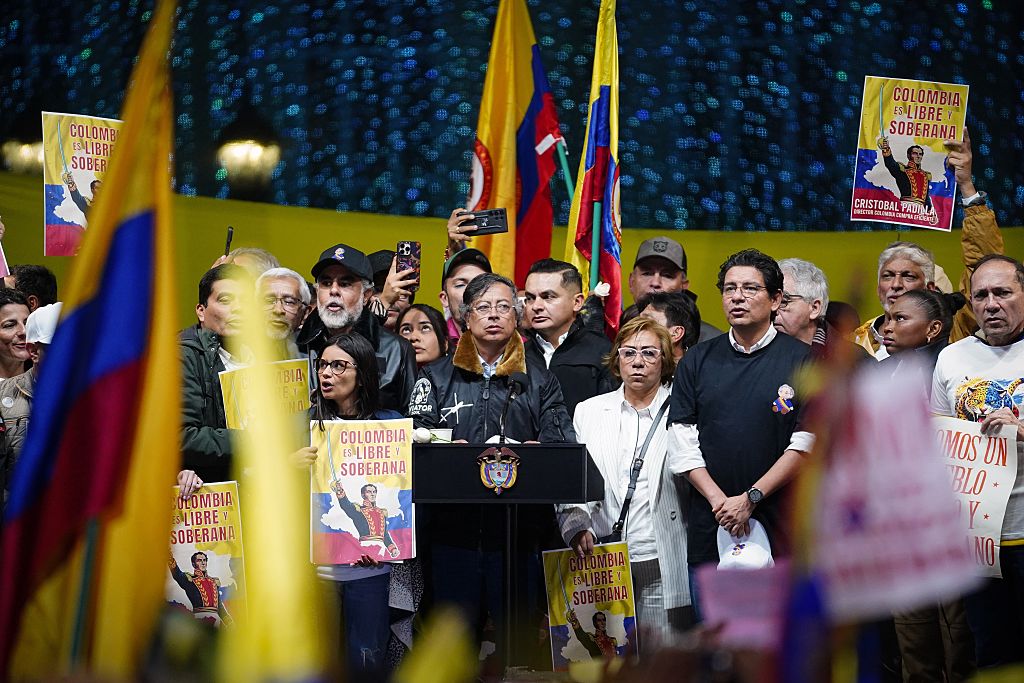Explainer: After the FARC, Colombia Still Has to Face Bacrim
Explainer: After the FARC, Colombia Still Has to Face Bacrim
Who are the Bacrim and what do they mean for Colombia’s peace negotiations?
If the Colombian government and the Revolutionary Armed Forces of Colombia meet their March 23, 2016, deadline to sign a peace agreement, and if Colombian voters approve it, the guerillas are then scheduled to disarm within 60 days. But that doesn’t mean the country will be at peace.
Observers say neo-paramilitary groups known collectively as Bacrim, short for bandas criminales or “criminal gangs,” are poised to become the greatest violent threat in Colombia once the FARC turn in their weapons. In Congress, Senator Iván Cepeda warned about the threat posed by Bacrim in light of the tenuous peace talks taking place in Havana with the Revolutionary Armed Forces of Colombia, known as the FARC. One of the government’s main negotiators in Cuba, Sergio Jaramillo, said that no peace deal will be successful without addressing the Bacrim problem.
FARC members are even worried that once they turn in their arms, the paramilitaries will turn on them, as happened in the 1980s and 1990s. During this time, paramilitaries, along with some corrupt wings of the Armed Forces, murdered hundreds of members of Patriotic Union, the political party co-founded by ex-rebels during a previous peace deal.
Where are the Bacrim?
A December 2015 report by the NGO Indepaz showed the growth of Bacrim groups in Colombia between 2013 and 2014. Although their total membership had dwindled, in 2014 they were present in over a third of Colombia’s 1,102 municipalities.
Among Bacrim, los Urabeños are the country’s largest illegal armed group after the FARC, with at least 2,600 members and a presence in 304 municipalities. By comparison, the latest data available show that the FARC has 6,700 members. They are followed by los Rastrojos, an offshoot from Valle del Cauca paramilitaries, whose membership was around 500, with a presence in 149 municipalities. A smaller group, las Águilas Negras, has a presence in only 27 municipalities, but its profile in the media is strong because of its custom of sending death threats to artists and human rights activists.
Bacrim are mostly active in the Pacific and Atlantic coasts—locations that allow them to smuggle drugs easily. They have also made their way to the large, mostly uninhabited, coca-growing plains of eastern Colombia, historically the territory of the smaller left-wing guerrilla National Liberation Army, known as the ELN.
Because of the spread of Bacrim across the country and their presence along cocaine trafficking routes, the Indepaz report concludes that there could be a “territorial regrouping of narco-paramilitary groups” in the wake of a ceasefire and a peace deal with the FARC.
Origins of the Bacrim
Bacrim groups were formed by members of the right-wing paramilitary group United Self-defense Forces of Colombia, known as the AUC, who did not want to join the demobilization process led by the Álvaro Uribe government between 2003 and 2006. In 2008, with the AUC dismantled, the Uribe government reneged on one of its pledges made during the demobilization process and extradited 14 paramilitary bosses to the United States. This prompted the remnant AUC members to declare they had reformed as los Urabeños so they could continue what they called the “anti-subversive” fight.
Colombian media subsequently reported that other neo-paramilitary groups were fighting each other and left-wing guerrillas to gain control of drug-smuggling routes and coca plantations. These groups have made various alliances between themselves, guerrillas, and drug cartels for criminal profit.
Criminals or criminals with an ideology?
The Colombian government’s stance is that Bacrim are not primarily pursuing an ideological goal like the FARC and the ELN, but rather are focused on profiting from criminal activities, such as drug trafficking, extortion, and illegal mining. President Juan Manuel Santos repeatedly argues that Bacrim are “organized crime gangs,” meaning that they are not considered a political organization and thus could not be included in the ongoing peace talks with the FARC.
Yet the growth of Bacrim in the last seven years worries politicians, public prosecutors, and even government negotiators in Havana that, after the peace deal is done, these groups will overtake FARC’s drug-trading routes, and achieve political influence, perpetuating the same cycle of violence the government is working to end.
The FARC, meanwhile, continues to argue that the Bacrim are an ideological continuation of paramilitary groups and, thus, part of the country’s civil conflict. FARC’s leader Rodrigo Londoño Echeverri, aka Timochenko, insisted in September 2015 that, to properly achieve a peace deal, “paramilitarism must be dismantled.” FARC leaders also argued in December that paramilitary and Bacrim leaders should be allowed into the transitional justice tribunals that will be created by the peace accord.
For now FARC leaders have accepted the exclusion of Bacrim from the peace talks, but the question of how will they influence the country’s criminal networks after FARC demobilizes remains open.








